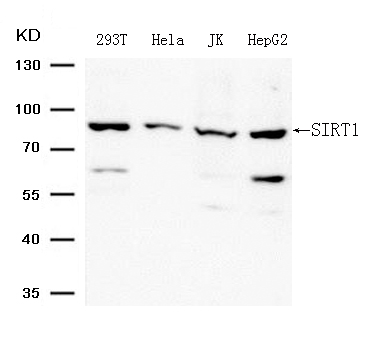
| WB | 咨询技术 | Human,Mouse,Rat |
| IF | 咨询技术 | Human,Mouse,Rat |
| IHC | 咨询技术 | Human,Mouse,Rat |
| ICC | 技术咨询 | Human,Mouse,Rat |
| FCM | 咨询技术 | Human,Mouse,Rat |
| Elisa | 咨询技术 | Human,Mouse,Rat |
| Aliases | SIR2L1 |
| Entrez GeneID | 23411; |
| WB Predicted band size | 82kDa |
| Host/Isotype | Rabbit IgG |
| Antibody Type | Primary antibody |
| Storage | Store at 4°C short term. Aliquot and store at -20°C long term. Avoid freeze/thaw cycles. |
| Species Reactivity | Human,Mouse,Rat |
| Immunogen | Peptide sequence around aa.342~346 (N-Y-T-Q-N) derived from Human SIRT1. |
| Formulation | Purified antibody in PBS with 0.05% sodium azide. |
+ +
以下是3篇与SIRT1抗体(可能与Ab-344相关)相关的参考文献摘要:
1. **"SIRT1 deacetylase protects against neurodegeneration in models of Alzheimer’s disease"**
- **作者**: Kim D, et al.
- **摘要**: 研究报道SIRT1通过去乙酰化作用调控tau蛋白和APP代谢,在阿尔茨海默病模型中减轻神经退行性病变,实验中使用了SIRT1特异性抗体验证其表达及定位。
2. **"Nutrient-sensitive mitochondrial NAD+ levels dictate cellular survival"**
- **作者**: Yang H, et al.
- **摘要**: 揭示SIRT1依赖的线粒体NAD+代谢在能量应激下的关键作用,通过Western blot(使用SIRT1抗体)证明其与FOXO3a的相互作用影响细胞凋亡。
3. **"SIRT1 regulates apoptosis and DNA damage response in cancer cells"**
- **作者**: Wang RH, et al.
- **摘要**: 发现SIRT1通过去乙酰化p53调控DNA损伤修复,研究中使用SIRT1抗体(Ab-344)进行免疫沉淀,证明其在肿瘤抑制中的双重功能。
注:Ab-344可能指向某公司特定抗体编号(如CST #2310),实际文献中可能未直接标注“Ab-344”,建议结合抗体说明书或供应商引用文献进一步验证。
SIRT1 (Ab-344) antibody is a phospho-specific antibody targeting the human sirtuin 1 (SIRT1) protein at a specific phosphorylation site, typically associated with serine or tyrosine residues. SIRT1. a member of the sirtuin family of NAD⁺-dependent deacetylases, plays a critical role in regulating cellular processes such as metabolism, stress response, aging, and epigenetic modification. Its activity is modulated by post-translational modifications, including phosphorylation, which influences subcellular localization, enzymatic activity, and interactions with substrates.
The Ab-344 epitope corresponds to a phosphorylated residue (e.g., Ser344 in some contexts) within SIRT1’s regulatory domain. This modification is implicated in pathways linked to energy homeostasis, DNA repair, and lifespan extension. Researchers use the SIRT1 (Ab-344) antibody primarily in techniques like Western blotting, immunoprecipitation, and immunofluorescence to study SIRT1’s phosphorylation status under conditions such as caloric restriction, oxidative stress, or pharmacological interventions.
Validation of this antibody often includes testing in SIRT1-deficient models to confirm specificity. Its application has advanced understanding of how phosphorylation fine-tunes SIRT1’s role in metabolic diseases, neurodegeneration, and cancer. However, users should verify cross-reactivity with homologs in other species and ensure appropriate controls to distinguish between phosphorylated and non-phosphorylated SIRT1 forms.
×